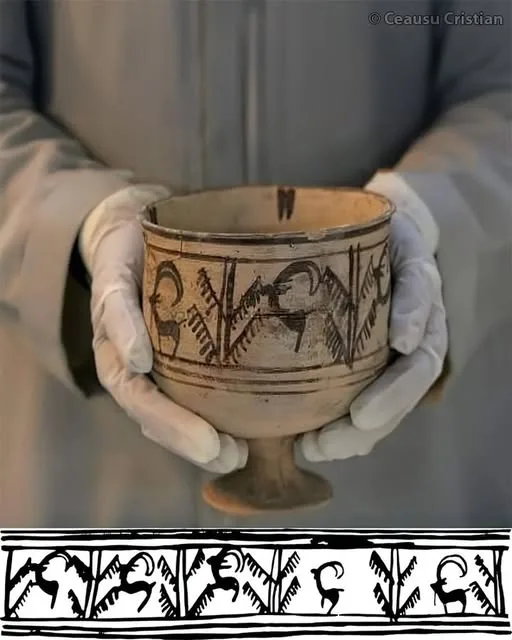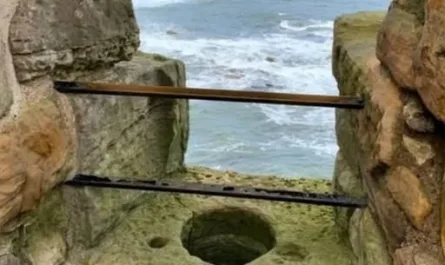Shahr-e Sukhteh Pottery Bowl: The Dawn of Animated Art in Iran
Unearthed from the ancient archaeological site of Shahr-e Sukhteh (Burnt City) in southeastern Iran, this remarkable pottery bowl, dating back approximately 5,200 years to around 3200–2800 BCE, stands as a potential pioneer of animated artwork. Featuring five sequential images of a wild goat leaping toward a tree, the bowl’s design suggests motion when viewed in order, marking it as a primitive form of animation. Discovered amid the ruins of this Bronze Age settlement, the artifact is now preserved in the Museum of Ancient Iran in Tehran. As of 10:40 PM MDT on July 5, 2025, this bowl offers a profound glimpse into the sophisticated creativity and cognitive abilities of early humans, illuminating their early attempts to capture narrative and movement in art.

Historical and Archaeological Context
Shahr-e Sukhteh, located in Sistan and Baluchestan Province, flourished as a major urban center of the Helmand culture during the Bronze Age, thriving from 3200 to 1800 BCE. Known for its advanced metallurgy, trade networks, and urban planning, the site was abandoned around 2100 BCE, possibly due to drought or seismic activity, leaving behind a treasure trove of artifacts. Excavations since the 1960s by Iranian archaeologists, including Ali Hakemi, have revealed a city of 5,000–10,000 residents, with the pottery bowl discovered in a residential area, suggesting it was a household item rather than a ceremonial object.
The bowl’s age, estimated at 5,200 years based on radiocarbon dating of associated layers, places it in the Early Bronze Age, a period when human societies were transitioning from Neolithic villages to complex urban centers. Its discovery highlights Shahr-e Sukhteh’s role as a cultural crossroads, influencing and influenced by neighboring regions like Mesopotamia and the Indus Valley.
Design and Craftsmanship
Crafted from local clay and fired at low temperatures, the bowl measures approximately 15 centimeters in diameter and 8 centimeters in height. Its exterior features five etched images of a wild goat—a common motif symbolizing agility and fertility—depicted in mid-leap toward a stylized tree. The sequence, arranged around the bowl’s circumference, creates a rudimentary animation effect when spun or viewed progressively, a technique some scholars liken to early zoetropes or flip-books.
Artistic Technique: The carvings, made with a sharp tool on wet clay before firing, show varying leg positions and head angles, suggesting intentional progression. The tree’s branches curve to guide the eye, enhancing the motion illusion.
Material and Preservation: The bowl’s reddish-brown surface, with black and white inlays, reflects the potter’s skill in manipulating clay and pigments, preserved remarkably due to the arid climate and burial conditions.
This craftsmanship indicates a high level of observational skill and abstract thinking, challenging the notion that such concepts emerged only in later civilizations.
Cultural and Cognitive Significance
The Shahr-e Sukhteh bowl is a milestone in art history, potentially the earliest known example of sequential imagery designed to imply movement. This suggests early humans were experimenting with storytelling and visual perception, possibly for entertainment, ritual, or education. The wild goat, a prevalent symbol in ancient Iranian art, may represent survival or a mythological narrative, with the tree symbolizing life or a sacred grove.
The artifact reflects advanced cognitive abilities for its time—around 3200 BCE—when writing was nascent, and visual art served as a primary communication tool. Comparisons to later Mesopotamian cylinder seals or Egyptian tomb paintings show a shared impulse to depict motion, though the bowl’s simplicity and portability distinguish it as a precursor.
Preservation and Exploration
Housed in the Museum of Ancient Iran, the bowl is part of a collection showcasing Shahr-e Sukhteh’s artifacts, including the world’s oldest artificial eyeball and backgammon set. The site itself, a UNESCO World Heritage site since 2014, is protected by Iran’s Cultural Heritage Organization, with ongoing excavations revealing more about its urban life. The bowl’s fragile state requires controlled humidity, with 2025 updates including a new display case to minimize light damage.
Visitors can view it during museum hours (9:00 AM–5:00 PM, closed Mondays), with an entry fee of 200,000 IRR (about $0.50 USD). Posts on X praise its “mind-blowing animation” and “ancient genius,” though access is limited by the museum’s Tehran location and international travel restrictions.
Challenges and Future Prospects
Preservation challenges include clay deterioration and the site’s vulnerability to looting and erosion, with recent 2025 satellite monitoring aiding protection. Future research, using 3D imaging and pigment analysis, could confirm the animation intent and reveal more about the artist’s tools. Collaboration with global institutions may expand its study, potentially linking it to similar finds across the ancient Near East.





